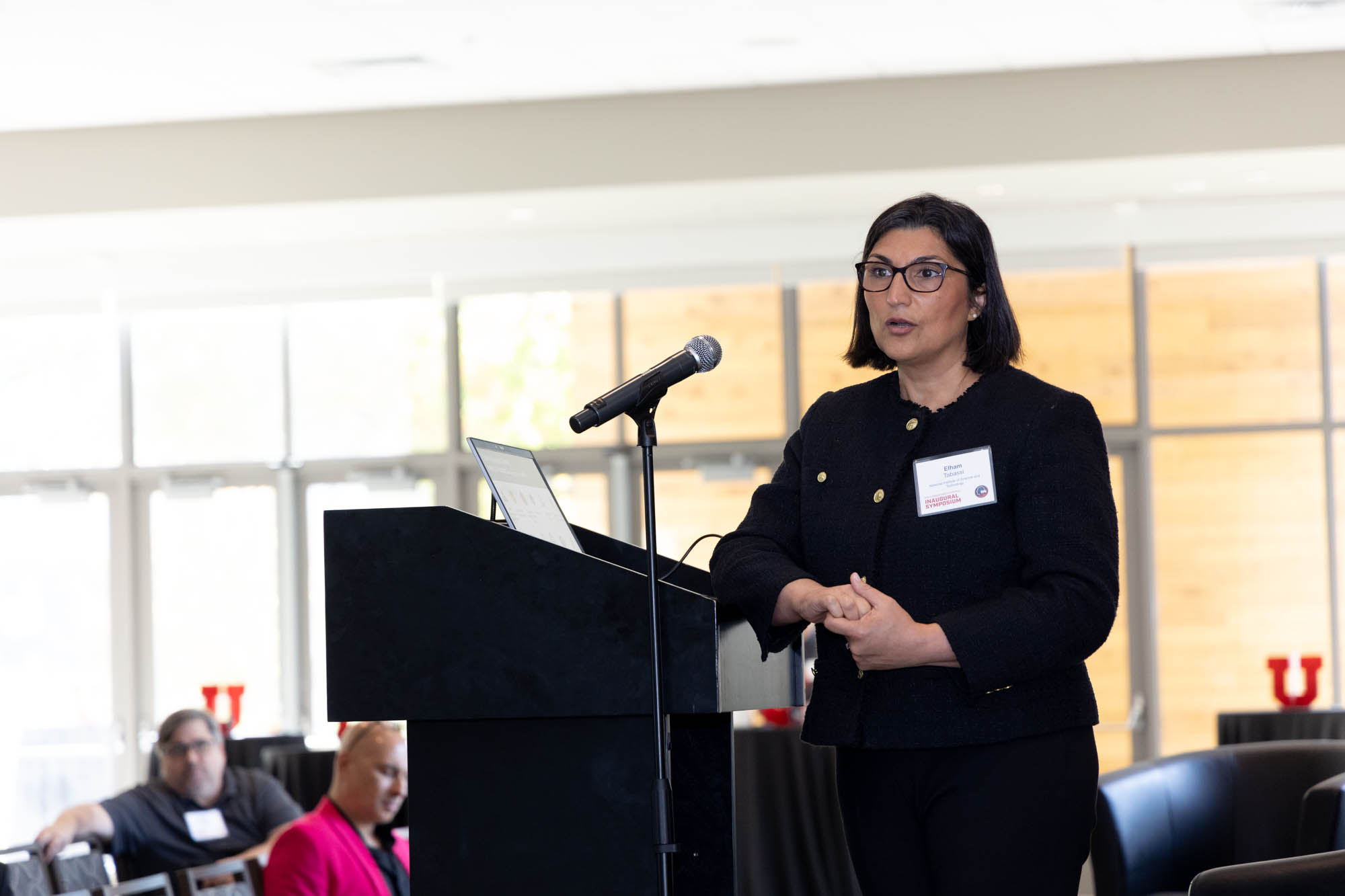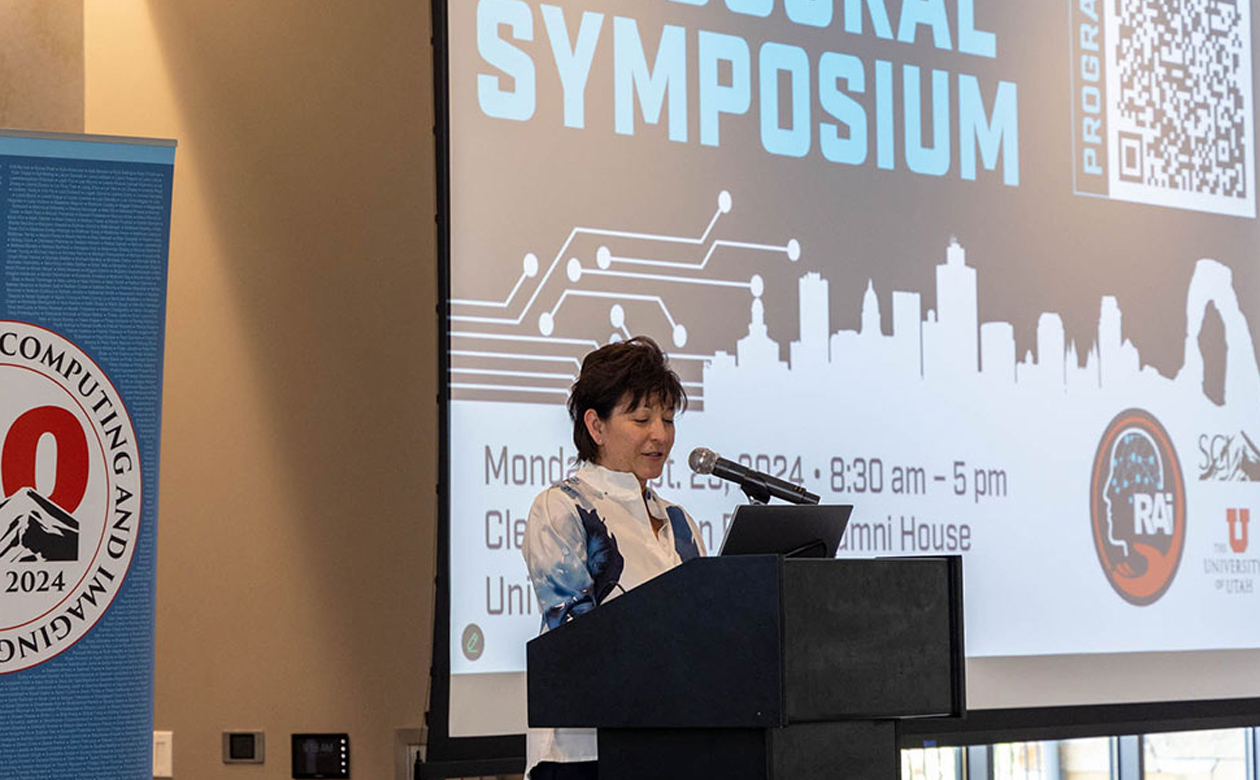The University of Utah One-U Responsible Artificial Intelligence Initiative (One-U RAI) hosted its Inaugural Symposium on Sept. 23 just shy of its first anniversary to share updates, showcase translational and applied AI work at the U, and spark discussions on how campus can leverage its collaborative culture to become a national leader in responsible AI.
About 200 people attended the daylong symposium at the Cleone Peterson Eccles Alumni House to hear from a wide-ranging roster of experts, including keynote speaker Elham Tabassi. Tabassi, one of TIME magazine’s “100 Most Influential People in AI” and a leader at the National Institute of Standards and Technology, spoke about “Framing and Taming AI Risks” and emphasized the need for a culture of responsible AI practices. The U is proactively building such a culture through One-U RAI, according to Mitzi Montoya, provost and senior vice president for academic affairs. In opening remarks, Montoya highlighted One-U RAI’s recently launched opportunities, including distinguished visitors, faculty fellows, and postdoctoral fellows, and coming in spring, cluster hires to grow the U’s pool of AI researchers.
“This project is on track. We’re moving very steadily and intentionally forward,” Montoya said. “Certainly, we believe the U is poised to lead the way nationally and to continue to build incredibly beneficial outcomes for society.”
Launched in October 2023 by President Taylor Randall and led by Scientific Computing and Imaging (SCI) Institute Director Manish Parashar, the $100 million One-U RAI supports transdisciplinary AI research with real-world impact in three areas where the U has deep expertise: the environment, health care and wellness, and teaching and learning. In February, One-U RAI appointed faculty members from departments across campus to serve in fast-action working groups charged with defining a mission and priorities for each area. On Sept. 23, working group representatives took the stage to talk about areas of interest for future One-U RAI fellows and hires.
 |
| Keynote speaker Elham Tabassi, one of TIME magazine’s “100 Most Influential People in AI” and a leader at the National Institute of Standards and Technology. |
Andrea Rorrer, education working group representative and director of the Utah Education Policy Center, said use cases included researching how AI can improve teaching and learning, provide virtual teaching assistants, and analyze student and course data to understand students’ academic progression through the U. Working group member Anne Cook, director of the Martha Bradley Evans Center for Teaching Excellence (CTE), discussed tools already in place or launching soon. AI 101 is a self-directed course to show faculty how they can use AI to do things like create lesson plans and assessments. CTE is also piloting an AI tool for faculty that analyzes data from student course feedback, provides insights into what’s working and what’s not, and suggests resources. CTE leaders hope the tool will support faculty development and curb failure rates in large introductory courses.
Wilkes Center for Climate Science and Policy Director William Anderegg represented the environment working group, which determined the U should focus on sustainable AI—how to develop AI with minimal environmental impact (e.g., consumption of energy, water and minerals) and maximal long-term sustainability—and how to harness AI for environmental resilience challenges, such as better models of climate and air quality. “This is where the multidisciplinary approach is incredibly powerful,” Anderegg said. It’s hard to follow a chain of evidence across fields—from measuring smoke in the atmosphere to measuring its impact on human health, for instance—but the U’s incredible research community, he said, can collaborate on those challenges. “The University of Utah could be one of the foremost places in connecting those dots,” Anderegg said.
Scientists can make such connections through data sharing and integration—a focus of the health care and wellness working group, represented by assistant professor of Psychiatry Nina de Lacy. The siloing of health care data within different systems, de Lacy said, hinders the development of concrete health care solutions. “For example, a very prominent problem here in the state of Utah: we have not advanced our ability to identify people at elevated risk for suicide in the last 50 years, in spite of intense efforts,” she said. “A big chunk of the blame for that goes to data fragmentation.” Speaker Nathan Blue, assistant professor of obstetrics and gynecology, underscored the opportunity to use medical data and AI to save lives. Blue’s team is developing a model to prevent stillbirths by guiding doctors’ only intervention: delivery. “The next step after having developed and tested this model and this framework is to scale up,” he said. “We need large-scale, granular data so that we can assess hard outcomes.”
Data sharing requires data stewardship—a topic speakers covered during two panel discussions. Marissa Saunders, senior director of data science at Recursion, said universities could contribute to AI innovation by serving as stewards for data sets used in training models. And when researchers are training AI models on patient data, privacy needs to be maintained, said Susan Gregurick, associate director of data science at the National Institutes of Health. “This is a grand challenge for somebody like Utah to take on,” she said. David Danks, professor of data science, philosophy, and policy at UC San Diego, echoed those ideas. “There’s a real need for entities that can be a trusted safe space for the data that can advance the sector without endangering the competitive advantages that each individual company has,” Danks said.
The symposium closed with a call for people to join One-U RAI efforts, including special interest groups on infrastructure, policy, frameworks and best practices, and workforce and education. “If you want to go fast, go alone, but if you want to go far, go together. We have this long journey of AI, and we have to go at it together,” Parashar said. “So come join us.”
In her opening remarks, Montoya also highlighted how broad community involvement is critical to One-U RAI’s success. “This is just the beginning,” she said, referring to the initiative’s first anniversary. “I hope where we are standing next year is in this place, celebrating some amazing outcomes and continuing to look forward to what we can do together.”
Watch the symposium on SCI’s YouTube channel and download the slide deck.

